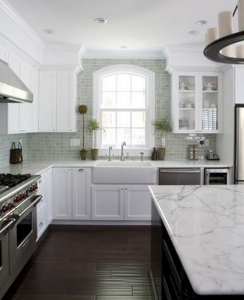When it comes to kitchen renovations or building a new kitchen, one of the primary considerations for homeowners is cost-effectiveness. Everyone wants a beautiful and functional kitchen, but they also want to ensure they’re getting the best value for their money. In this guide, we’ll explore different types of kitchens and analyse their cost-effectiveness to help you make an informed decision for your home.

1. Basic or Standard Kitchens
Basic or standard kitchens are typically the most cost-effective option for homeowners. These kitchens feature simple designs, standard materials, and basic appliances. They are functional and practical but may lack some of the bells and whistles of more luxurious kitchens.
Cost-Effectiveness: Basic kitchens are budget-friendly, making them an excellent choice for homeowners on a tight budget or those looking to renovate investment properties. By keeping designs simple and using standard materials, you can save significantly on both construction and installation costs.
Pros:
– Affordable upfront costs
– Quick and straightforward installation process
– Minimal maintenance and repair expenses
Cons:
– Limited Personalisedisation options
– Less durable materials may require replacement sooner
– Lacks high-end features and finishes
2. Modular Kitchens
Modular kitchens are pre-designed and pre-fabricated kitchen units that can be easily assembled and installed in your home. These kitchens offer a balance between affordability and personalisation, allowing homeowners to choose from a variety of modules, finishes, and accessories to suit their needs and budget.
Cost-Effectiveness: Modular kitchens are generally more cost-effective than Personalised kitchens because they are mass-produced, which reduces manufacturing and installation costs. Additionally, their modular nature means they can be easily modified or expanded over time, allowing homeowners to adapt their kitchens to changing needs and budgets.
Pros:
– Affordable upfront costs
– Wide range of design options and finishes
– Quick and easy installation process
– Flexibility to add or remove modules as needed
Cons:
– Limited personalisation compared to Personalised kitchens
– Quality of materials and finishes may vary
– Some assembly required, which may require professional help
3. Personalised Kitchens
Custom made kitchens Sydney are tailor-made to suit your specific requirements and preferences. These kitchens offer the ultimate in design flexibility, allowing you to choose every aspect of your kitchen, from layout and materials to appliances and finishes. While Personalised kitchens offer unparalleled luxury and personalisation, they typically come with a higher price tag.
Cost-Effectiveness: Personalised kitchens are the least cost-effective option due to their high upfront costs. Personalised kitchens involve detailed planning, design, and fabrication processes, which can be time-consuming and expensive. Additionally, the use of premium materials, appliances, and finishes adds to the overall cost of personalised kitchens.
Pros:
– Unlimited design possibilities
– Highest level of personalisation
– Premium quality materials and finishes
– Potential to increase home value
Cons:
– Highest upfront costs
– Longer lead times for design and fabrication
– Requires professional design and installation
– Higher maintenance and repair expenses over time

Factors Influencing Cost-Effectiveness
Several factors can influence the cost-effectiveness of a kitchen, regardless of its type. These include:
- Size of the Kitchen: Larger kitchens generally cost more to renovate or build than smaller kitchens due to the increased material and labour costs.
- Materials and Finishes: The choice of materials and finishes can significantly impact the overall cost of a kitchen. While basic materials are more affordable, premium materials can add to the expense.
- Appliances: High-end appliances can significantly increase the cost of a kitchen. However, investing in energy-efficient appliances may result in long-term savings on utility bills.
- Labour Costs: Labour costs vary depending on location, complexity of the project, and skill level required. Hiring reputable professionals can ensure quality workmanship but may come at a higher price.
- Design and Layout: Complex designs and personalised layouts may require additional time and resources to execute, resulting in higher costs.
Conclusion
When it comes to choosing a cost-effective kitchen, it’s essential to consider your budget, lifestyle, and long-term goals. While basic and modular kitchens offer affordability and practicality, personalised kitchens provide unparalleled luxury and personalisation. Ultimately, the best type of kitchen for you will depend on your individual preferences, priorities, and financial considerations.
By carefully weighing the pros and cons of each type of kitchen and consulting with experienced professionals, you can make an informed decision that meets your needs and budget. Whether you opt for a basic, modular, or personalised kitchen, investing in a well-designed and functional space will enhance your home’s value and your quality of life for years to come.
For more kitchen renovation ideas and inspiration, explore our collection of flat pack kitchens Sydney projects.

